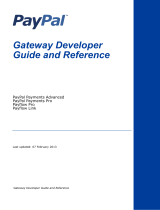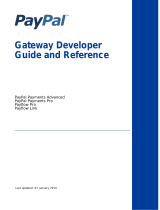
MPPGV3 for WorldPay - DynaPro
6
3 Command of the DynaPro by the Host
The host can connect to the DynaPro either via USB (including Part Numbers 30056001, 30056003,
30056013, 30056028) or over a local IP network (including Part Numbers 30056005, 30056007,
30056030). Command of the DynaPro can be accomplished via any of the following access methods:
Directly by sending byte-level commands, via a MagTek SDK available for a variety of operating
systems, or via MagTek’s MagneFlex. This guide will indicate the DynaPro commands and arguments for
MagneFlex (version Blue, Navy, or Sky) or the low-level byte commands that must be used for the
operational regimes described above. These will be expressed in the document as MagneFlex key:value
(low-level byte command). Please see a MagTek representative for other options, and for the appropriate
guides to DynaPro, DynaPro SDKs or MagneFlex.
3.1 EMV Transaction Initiation
To initiate an EMV transaction, the requestStartEMVTransaction (Command 0xA2) is sent to the device
with a set of arguments. Most arguments are fixed and should not be changed. Those available for change
are shown in blue.
• endSession:true (MagneFlex only)
• waitbeforendsession:3000 - The number of milliseconds before MagneFlex resets the DynaPro
for the next transaction after the customer is asked to remove their card.
• timeLimit:3c (Byte 1:0x3c) – This corresponds to a wait time of 60 seconds for the cardholder to
interact with the DynaPro. Other values may be used but are not recommended.
• reserved:00000000000000000000000008400001 (Byte
20..35:0x00000000000000000000000008400001)
• cardType:03 (Byte 5:0x03)
• option:00 (MagneFlex only)
• amount:9.99 (Byte 7..12:000000000999) – This is a fixed, plug amount, NOT the SALE amount.
Do not change.
• transactionType:08 (Byte 13:0x08)
3.1.1 DynaPro Output
Upon a successful interaction with the cardholder, the DynaPro will respond with a TLV-formatted data
container containing TLV tags. Further information about the TLV format may be found in a later section.
The container will include, at a minimum, the following TLV tags (see the DynaPro Programmer’s
Manual or MagneFlex documentation for further details):
• DFDF59 (Encrypted Data Primitive) – The encrypted cardholder data.
• DFDF56 (Key Serial Number) – The serial number of the key used to encrypt the data.
• DFDF58 (Number of Bytes of Padding) – The number of pad bytes used in the Encrypted Data
Primitive.
• DFDF53 (Fallback Indicator) – Used to determine the value for the MPPGV3 PaymentMode
field.
3.2 KeyPadEntry Transaction Initiation
To initiate the entry of card data on the keypad (KeyPad), use requestManualCard (Command 0x11)
using the following arguments:
• endSession:true (MagneFlex only)
• timeLimit:FF (Byte 1:0xFF) – This corresponds to a wait time of 255 seconds for the cardholder
to interact with the DynaPro. Other values may be used but are not recommended.


















